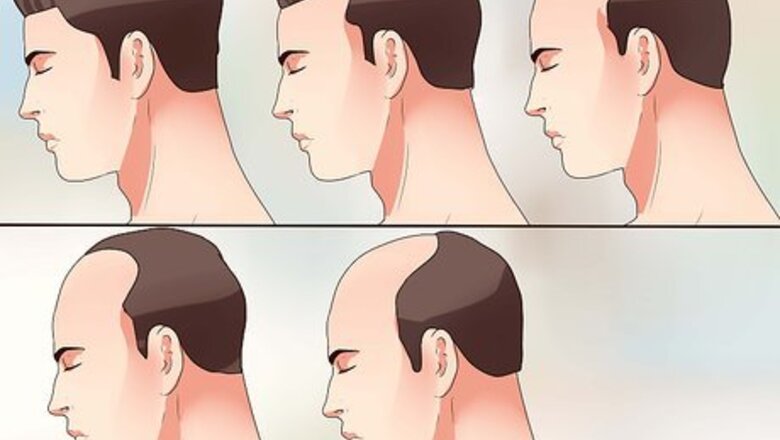
views
Measuring Male Pattern Baldness
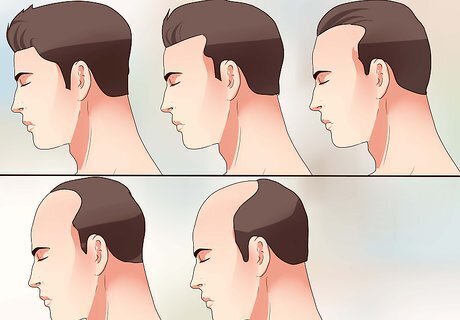
Learn about the Norwood/Hamilton Scale. The Norwood/Hamilton scale is the accepted scale for assessing male pattern baldness, first introduced by Dr. James Hamilton in the 1950s. If you suffer from male pattern baldness, being able to identify your level of hair loss as falling somewhere in one of the seven stages identified by the Norwood/Hamilton scale can help a doctor determine how the best treatment method. There will be times when you have to explain your level of hair loss over the phone to a doctor or physician. Being able to point to a stage on the Norwood/Hamilton Scale will be helpful. The Norwood/Hamilton Scale also protects against misdiagnosis. You can make sure your hair loss is following the pattern of male baldness and not merely the result of aging.
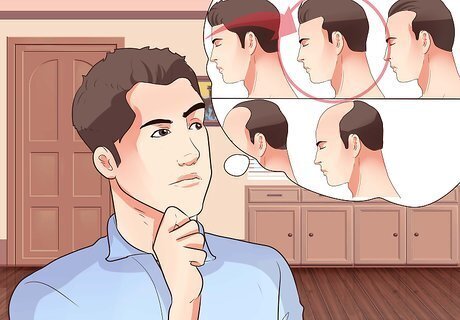
Figure out which of the seven stages you fall into. There are 7 stages of the Norwood/Hamilton Scale used to assess male pattern baldness. Figure out which of the seven stages best reflects your hair loss. Stage One, which sometimes goes unnoticed, is marked by a very minor recession of the hairline and does not require treatment. Unless you have a family history of baldness, you do not need to worry about Stage one. Stage Two is marked by a triangular recession of the hair lining the frontal temporal areas. The hair around your ears will also recede by several centimeters. Baldness becomes more apparent in this stage. Stage Three is the lowest level of hair loss needed for a person to be considered bald. Temples will be bare, only covered by sparse hair, and the hair towards the front of the head will begin to form a crown. Stage four is marked by these symptoms becoming more severe, and hair further thinning and receding around the temples and the front of the head. In Stage Five, the band of hair that extends across the crown thins. Hair loss around the temples and the ears become larger and more noticeable. This continues into Stage Six, when the bridge of hair across the crown is totally lost. Stage Seven is the most advanced form of hair loss. There is only a narrow band of horseshoe-shaped hair on the sides of the head and the back of the scalp. There may be some hair, forming a semi-circle, over both ears.

Seek treatment before reaching Stage Seven. Once you've reached Stage Seven, hair loss becomes very difficult to treat. If you want to combat male pattern baldness, seek out the advice of a doctor and physician to figure out how to best treat your hair loss before you reach Stage Seven.
Measuring Female Pattern Baldness
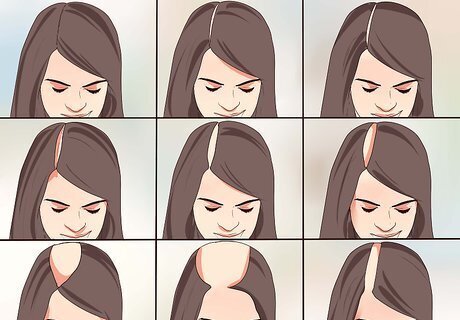
Be aware of the limitations of the Ludwig Scale. The Ludwig Scale is a scale for measuring the progression of hair loss in females. While it can be a useful tool for assessing and explaining your level of hair loss, it has some limitations. The Ludwig Scale was made to address female baldness as the patterns of balding in females are often different than in males. Baldness is more a progressive thinning of hair in females. However, sometimes women's hair thins and recedes similar to men's hair, so the Ludwig Scale might not work.

Figure out which the of the three types of hair loss you fall into. There are three types of baldness outlined by the Ludwig Scale. Type I is marked by hair receding and thinning on the top of the head. It may be hard to notice at this stage, but you may notice a bigger white patch than usual when you part your hair. The frontal hairline usually does not recede at this stage. Type II is marked by thinning, shedding, and a general decrease in volume of the hair overall. Your center part will also continue to widen. Treatment may be necessary at this stage of hair loss. Type III is the most extreme type of female hair loss. Hair is so thin it may not cover the scalp and will be noticeable to most people. Hair will also continue to thin and lose moisture.
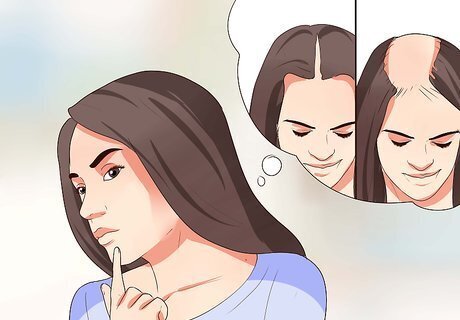
Recognize the signs of advanced and frontal baldness. Female hair loss is not confined to the Ludwig Scale. It can also be frontal and advanced. Advanced baldness is rarely seen in patients, but it's marked by almost no hair being present on the crown or the top of the head. Some women experience a gradual receding of the hairline, much the same way as baldness occurs in male patients. If this is the case for you, ask a physician if you should use the Norwood/Hamilton Scale instead to measure your hair loss.
Trying Other Means

Use an online tool. If you're unsure which hair loss scale to use to measure your baldness, you can try using an online tool. Many websites have hair loss calculators that help you diagnose your level of baldness. Usually, the tools will allow you to put in basic information such as your age and whether or not baldness runs in your family. The tool will also allow you to select your level of baldness, based on visual aids provided as well as multiple choice questions. The tool will give you a level of baldness and suggest treatment options. However, you should never undergo any hair loss treatment without first consulting your regular physician.

Try non-invasive measures. A doctor can advise you on the best ways to measure your hair loss if standard scales do not work for you. Your doctor will probably go over non-invasive measures first. Your doctor might have you take a daily questionnaire, where you choose answers from a series of multiple choice questions regarding your level of hair loss. While questionnaires are easy and non-invasive, they are highly subjective and may not provide you with an accurate measure of hair loss. Daily hair counts involve collecting strands of hair in a bag and counting them at the end of the day. Most people lose about 100 strands of hair a day and if you're losing more you may be at risk for baldness. In a standardized wash test, you refrain from shampooing your hair for five days and then shampoo and rinse your hair in a basin with the hole covered by gauze. You will collect the hairs and send them to your doctor for evaluation. Global photography involves photographing hair with special equipment at a doctor's office, equipped with lighting and magnification to assess hair loss. This is a more precise level of evaluating hair loss than other non-invasive measures.
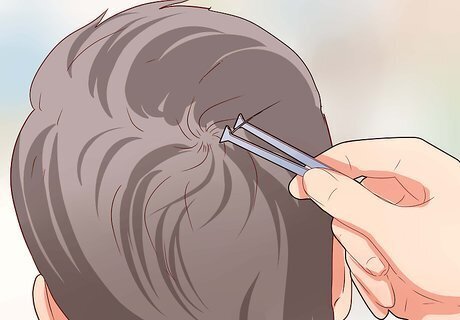
Try semi-invasive and invasive procedures. If your doctor think you're at a high risk for hair loss, she might recommend trying invasive or semi-invasive procedures to evaluate hair loss. A hair pluck test, known medically as a trichogram, involves taking hairs from specific parts of the scalp after five days of using a specialized shampoo. The hair is then evaluated in a lab to assess the level of hair loss. A UAT exam involves marking a fixed area on the scalp with a fiber tip pen. Then, all the hairs within the line are evaluated individually with tweezers or other devices at a doctor's office. While this can provide an accurate measure of hair loss, it can also be quite painful. Scalp biopsies are usually used if your doctor suspects you may have a hair loss disorder like alopecia. The biopsy is usually performed under anesthesia, and a 4 millimeter bit of scalp is taken for examination.
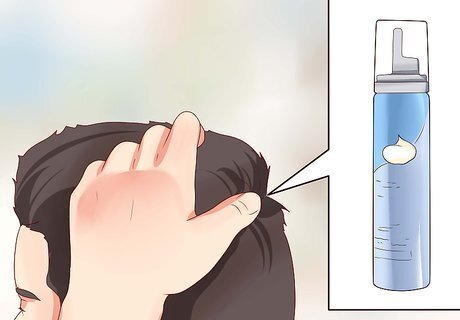
Seek treatment. Once you've assessed your level of hair loss, make an appointment with your physician to discuss treatment options. Minoxidil (Rogaine) is a foam you rub into your scalp twice a day to combat hair loss. It can be used by both men and women and can encourage hair growth or stop further hair loss. Side effects might include scalp itchiness, hair growth on the face, and rapid heart rate. Finasteride (Propecia) is a prescription drug, taken in pill form, available only to men. It is designed to slow hair loss. Side effects might include diminished sex drive or difficulty with sexual performance, although such side effects are rare. Hair loss surgery is sometimes recommended in extreme cases. Usually, plugs of skin from the back of the scalp are transported into the bald sections. Surgery can be painful, and scarring is a risk. Laser therapy is a somewhat new technique used to treat baldness in both men and women. The long term effect of this therapy is not known, but it has shown to reduce baldness in some patients.

Recognize normal hair loss. If your notice you've entered Stage One on either hair loss scales, this might be normal hair thinning and loss that comes with age. If you're in your 40s or 50s and there is not a history of baldness in your family, this is likely normal hair thinning that comes with age and probably does not warrant treatment.













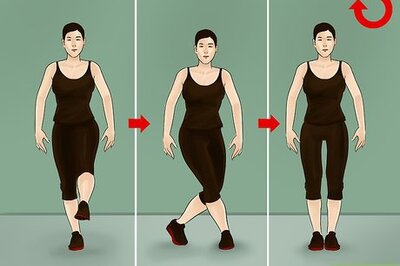




Comments
0 comment